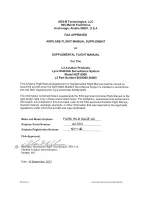
Aetos Installation Manual
14.1
Fuel Level Sensors
There are no points in the
Measurements
list.
Sensor
value is informa-
tive and shows the readings from the sensor. This value is either voltage
or resistance detected by Daqu – this depends on the sensor type.
3. Slowly pour some fuel into the tank and observe when the
Sensor
value
starts changing. Usually sensors will not react immediately, as they
can’t reach the true low fuel point. Select the
Add point
item and set
the
Fuel Quantity
value to zero
(a)
Starting situation.
(b)
First point was added.
Figure 68:
Editing tank measurement points.
4. Pour more fuel in known steps. 5-20 liter steps are usually fine. Use
larger steps for very large tanks. Wait for sensor value to stabilize. Then
select the
Add point
and set the cumulative fuel quantity for this step.
5. Repeat the previous step until the sensor value stops changing. When
this happens the upper sensor limit point has been reached. Putting
more fuel into tank will have no effect on the sensor. Sensors in many
aircraft reach this point way before true fuel tank capacity is reached.
6. Close the editing window. The fuel tank has been calibrated and the
tank specific shape will be shown on the window.
6
Here, in fact are two possible approaches. You can set the value to zero and then
starting counting fuel from this point on. Any amount of fuel poured into tank before
this point is a kind of reserve. During flight, if you reach the zero, you still have some
reserve
in tank. But do not count on this.
The other alternative is not to enter zero, but correct amount of fuel. In this case,
tank indication will never reach zero during flight, but only the value at the low sensor
position even though the true fuel quantity will be smaller. This can be misleading, so
we advocate NOT to use this approach.
73
©
Kanardia
2019–2020




























